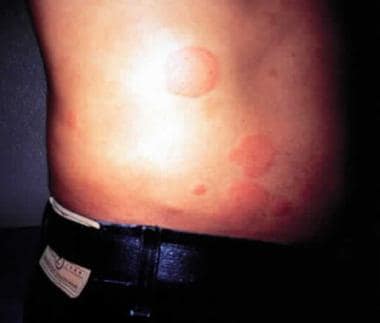Practice Essentials
Urticaria appears as raised, well-circumscribed areas of erythema (redness) and edema (swelling) involving the dermis and epidermis that are very pruritic (itchy), as shown in the image below. Acute urticaria can be caused by allergic reactions to foods, drugs, cosmetics, or soaps; infections; insect bites, stings, or exposure; environmental factors; latex; undue skin pressure, cold, or heat; emotional stress; and exercise, among other factors. It may be acute (< 6 wk) or chronic (>6 wk). Urticaria may be confused with a variety of other dermatologic diseases that are similar in appearance and are also pruritic; usually, however, it can be distinguished from these diseases by an experienced clinician.
Urticaria is not contagious, unless the swollen hives themselves contain a pathogen.
Urticaria developed after bites from an imported fire ant.
Signs and symptoms of urticaria
Information regarding history of previous urticaria and duration of rash and itching is useful for categorizing urticaria as acute, recurrent, or chronic. For chronic or recurrent urticaria, important considerations include previous causative factors and the effectiveness of various treatments, as follows
:
Precipitants, such as heat, cold, pressure, exercise, sunlight, emotional stress, or chronic medical conditions
Other medical conditions that can cause pruritus (usually without rash), such as diabetes mellitus, chronic renal insufficiency, primary biliary cirrhosis, or other nonurticarial dermatologic disorders
Family and personal medical history of angioedema – Characteristics of angioedema
include vasodilation and exudation of plasma into the deeper tissues more so than with simple urticaria; angioedema can occur with and without the wheals (hives) of simple urticaria and presents clinically as subcutaneous swelling that is generally nonpitting and nonpruritic; it can affect the mouth as well as the mucosal surfaces of the respiratory and GI tracts, manifesting as hoarseness and GI upset; it can be a feature of anaphylaxis if the throat is involved, leading to airway compromise
For acute urticaria, the main consideration involves possible precipitants, such as the following
:
Recent illness
Medication use
IV radiocontrast media
Travel
Foods
New perfumes, hair dyes, detergents, lotions, creams, or clothes
Exposure to new pets (dander), dust, mold, chemicals, or plants
Pregnancy (usually occurs in last trimester and typically resolves spontaneously soon after delivery)
Contact with nickel, rubber, latex, industrial chemicals, and nail polish
Sun or cold exposure
Exercise
Alcohol ingestion
Physical urticaria is characterized by the following:
Blanchable, raised, palpable wheals, which can be linear, annular (circular), or arcuate (serpiginous); can occur on any skin area; are usually transient and migratory; and may coalesce rapidly to form large areas of erythematous, raised lesions that blanch with pressure
Dermographism or dermatographism (urticarial lesions resulting from light scratching)
The physical examination should focus on conditions that might precipitate urticaria or could be potentially life-threatening and include the following
:
Angioedema of the lips, tongue, or larynx
Individual urticarial lesions that are painful, long-lasting (>24 h), or ecchymotic or that leave residual hyperpigmentation or ecchymosis upon resolution are suggestive of urticarial vasculitis
Systemic signs or symptoms
Scleral icterus, hepatic enlargement, or tenderness
Thyromegaly
Pneumonia or bronchospasm (asthma)
Cutaneous evidence of bacterial or fungal infection
See Clinical Presentation for more detail.
Diagnosis
Laboratory studies may be helpful, as follows:
Acute urticaria (< 6 wk) – Laboratory studies generally are not indicated
Chronic or recurrent urticaria (>6 wk) – Basic laboratory studies should include complete blood count (CBC), erythrocyte sedimentation rate (ESR), thyroid-stimulating hormone (TSH), and antinuclear antibody (ANA)
Other studies that may be considered include the following:
Imaging studies – Generally not indicated unless suggested by a specific symptom or sign
Punch biopsy – If urticarial vasculitis is suspected
See Workup for more detail.
Management
Acute urticaria may rarely progress to life-threatening angioedema or anaphylactic shock in a very short period, although anaphylactic shock is usually of rapid onset with no urticaria or angioedema.
Prehospital measures may include the following when there is concern for anaphylactic shock:
If associated angioedema is present, IM epinephrine
If associated bronchospasm is present, nebulized albuterol
Other measures may be appropriate, such as continuous ECG, blood pressure and pulse oximetry monitoring; administering intravenous crystalloids if the patient is hypotensive; and administering oxygen.
Diphenhydramine or hydroxyzine, if available
Management of urticaria is focused on treating the symptoms and typically is not altered by underlying etiology. The mainstay is avoidance of further exposure to the antigen causing urticaria. Pharmacologic treatment options include the following:
Antihistamines, primarily those that block H1 receptors with low sedating activity, such as fexofenadine, loratadine, desloratadine, cetirizine, and levocetirizine are first-line therapy
; these are preferred over diphenhydramine and hydroxyzine; H2 antihistamines, such as cimetidine, famotidine, and ranitidine, may have a role when used in combination with H1 antihistamines, although the benefit is unclear
Doxepin
Omalizumab
Glucocorticoids
Epinephrine (controversial in acute urticaria)
Methotrexate, colchicine, dapsone, indomethacin, and hydroxychloroquine (for urticarial vasculitis)
Topical 5% doxepin cream or capsaicin (refractory cases)
Patients with chronic or recurrent urticaria should be referred to a dermatologist for further evaluation and management.
Consultation with or referral to a dermatologist, allergist, immunologist, or rheumatologist may be appropriate in selected cases, particularly in cases of complicated, recurrent, refractory, severe, or chronic urticaria. Dermatology referral is mandatory if urticarial vasculitis is suspected.
See Treatment and Medication for more detail.

